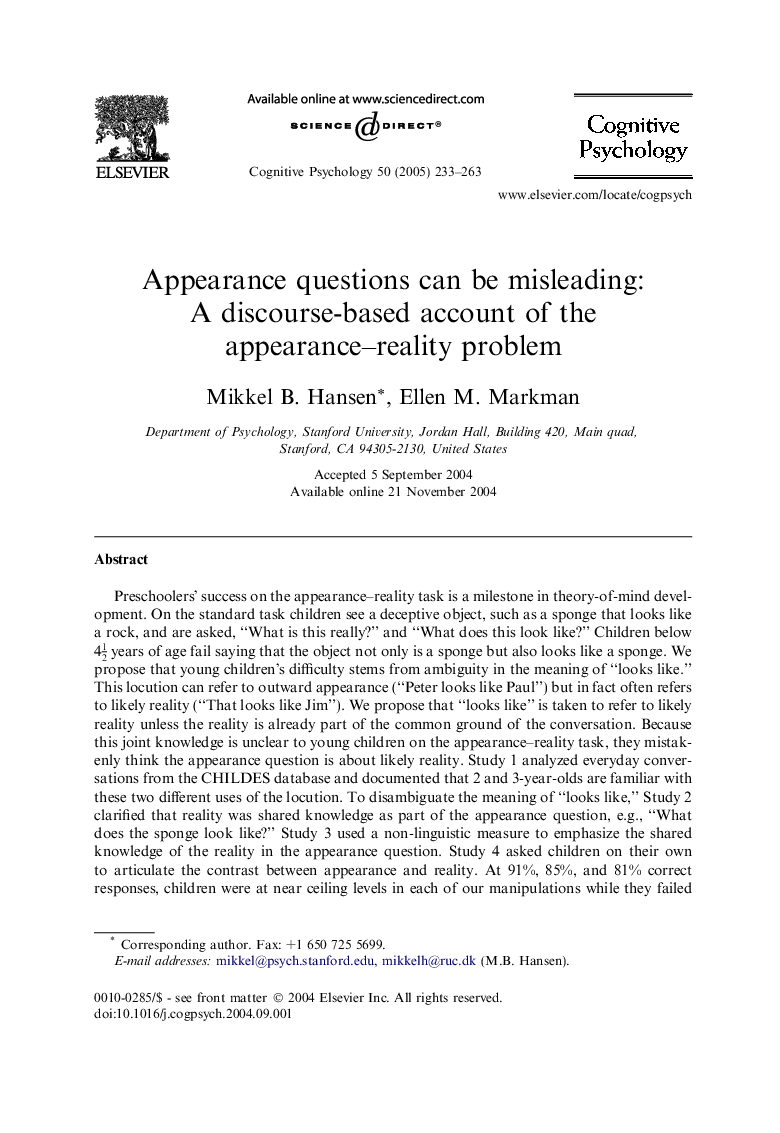| کد مقاله | کد نشریه | سال انتشار | مقاله انگلیسی | نسخه تمام متن |
|---|---|---|---|---|
| 10452464 | 919059 | 2005 | 31 صفحه PDF | دانلود رایگان |
عنوان انگلیسی مقاله ISI
Appearance questions can be misleading: A discourse-based account of the appearance-reality problem
دانلود مقاله + سفارش ترجمه
دانلود مقاله ISI انگلیسی
رایگان برای ایرانیان
موضوعات مرتبط
علوم زیستی و بیوفناوری
علم عصب شناسی
علوم اعصاب شناختی
پیش نمایش صفحه اول مقاله

چکیده انگلیسی
Preschoolers' success on the appearance-reality task is a milestone in theory-of-mind development. On the standard task children see a deceptive object, such as a sponge that looks like a rock, and are asked, “What is this really?” and “What does this look like?” Children below 412 years of age fail saying that the object not only is a sponge but also looks like a sponge. We propose that young children's difficulty stems from ambiguity in the meaning of “looks like.” This locution can refer to outward appearance (“Peter looks like Paul”) but in fact often refers to likely reality (“That looks like Jim”). We propose that “looks like” is taken to refer to likely reality unless the reality is already part of the common ground of the conversation. Because this joint knowledge is unclear to young children on the appearance-reality task, they mistakenly think the appearance question is about likely reality. Study 1 analyzed everyday conversations from the CHILDES database and documented that 2 and 3-year-olds are familiar with these two different uses of the locution. To disambiguate the meaning of “looks like,” Study 2 clarified that reality was shared knowledge as part of the appearance question, e.g., “What does the sponge look like?” Study 3 used a non-linguistic measure to emphasize the shared knowledge of the reality in the appearance question. Study 4 asked children on their own to articulate the contrast between appearance and reality. At 91%, 85%, and 81% correct responses, children were at near ceiling levels in each of our manipulations while they failed the standard versions of the tasks. Moreover, we show how this discourse-based explanation accounts for findings in the literature. Thus children master the appearance-reality distinction by the age of 3 but the standard task masks this understanding because of the discourse structure involved in talking about appearances.
ناشر
Database: Elsevier - ScienceDirect (ساینس دایرکت)
Journal: Cognitive Psychology - Volume 50, Issue 3, May 2005, Pages 233-263
Journal: Cognitive Psychology - Volume 50, Issue 3, May 2005, Pages 233-263
نویسندگان
Mikkel B. Hansen, Ellen M. Markman,